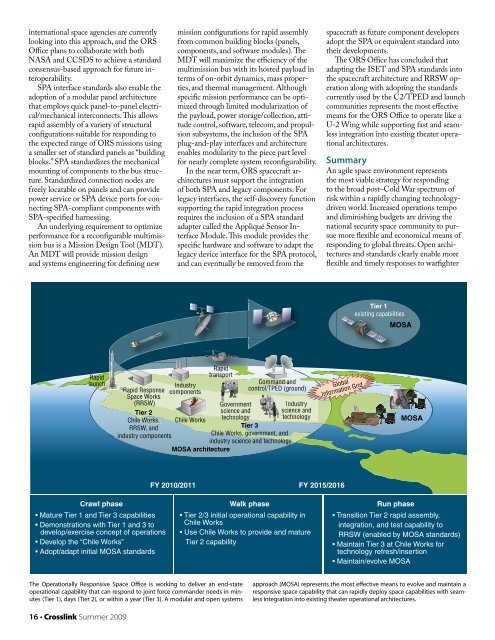Developing Responsive and Agile Space Systems - Space-Library
Developing Responsive and Agile Space Systems - Space-Library
Developing Responsive and Agile Space Systems - Space-Library
Create successful ePaper yourself
Turn your PDF publications into a flip-book with our unique Google optimized e-Paper software.
international space agencies are currently<br />
looking into this approach, <strong>and</strong> the ORS<br />
Office plans to collaborate with both<br />
NASA <strong>and</strong> CCSDS to achieve a st<strong>and</strong>ard<br />
consensus-based approach for future interoperability.<br />
SPA interface st<strong>and</strong>ards also enable the<br />
adoption of a modular panel architecture<br />
that employs quick panel-to-panel electrical/mechanical<br />
interconnects. This allows<br />
rapid assembly of a variety of structural<br />
configurations suitable for responding to<br />
the expected range of ORS missions using<br />
a smaller set of st<strong>and</strong>ard panels as “building<br />
blocks.” SPA st<strong>and</strong>ardizes the mechanical<br />
mounting of components to the bus structure.<br />
St<strong>and</strong>ardized connection nodes are<br />
freely locatable on panels <strong>and</strong> can provide<br />
power service or SPA device ports for connecting<br />
SPA-compliant components with<br />
SPA-specified harnessing.<br />
An underlying requirement to optimize<br />
performance for a reconfigurable multimission<br />
bus is a Mission Design Tool (MDT).<br />
An MDT will provide mission design<br />
<strong>and</strong> systems engineering for defining new<br />
mission configurations for rapid assembly<br />
from common building blocks (panels,<br />
components, <strong>and</strong> software modules). The<br />
MDT will maximize the efficiency of the<br />
multimission bus with its hosted payload in<br />
terms of on-orbit dynamics, mass properties,<br />
<strong>and</strong> thermal management. Although<br />
specific mission performance can be optimized<br />
through limited modularization of<br />
the payload, power storage/collection, attitude<br />
control, software, telecom, <strong>and</strong> propulsion<br />
subsystems, the inclusion of the SPA<br />
plug-<strong>and</strong>-play interfaces <strong>and</strong> architecture<br />
enables modularity to the piece part level<br />
for nearly complete system reconfigurability.<br />
In the near term, ORS spacecraft architectures<br />
must support the integration<br />
of both SPA <strong>and</strong> legacy components. For<br />
legacy interfaces, the self-discovery function<br />
supporting the rapid integration process<br />
requires the inclusion of a SPA st<strong>and</strong>ard<br />
adapter called the Appliqué Sensor Interface<br />
Module. This module provides the<br />
specific hardware <strong>and</strong> software to adapt the<br />
legacy device interface for the SPA protocol,<br />
<strong>and</strong> can eventually be removed from the<br />
spacecraft as future component developers<br />
adopt the SPA or equivalent st<strong>and</strong>ard into<br />
their developments.<br />
The ORS Office has concluded that<br />
adapting the ISET <strong>and</strong> SPA st<strong>and</strong>ards into<br />
the spacecraft architecture <strong>and</strong> RRSW operation<br />
along with adopting the st<strong>and</strong>ards<br />
currently used by the C2/TPED <strong>and</strong> launch<br />
communities represents the most effective<br />
means for the ORS Office to operate like a<br />
U-2 Wing while supporting fast <strong>and</strong> seamless<br />
integration into existing theater operational<br />
architectures.<br />
Summary<br />
An agile space environment represents<br />
the most viable strategy for responding<br />
to the broad post–Cold War spectrum of<br />
risk within a rapidly changing technologydriven<br />
world. Increased operations tempo<br />
<strong>and</strong> diminishing budgets are driving the<br />
national security space community to pursue<br />
more flexible <strong>and</strong> economical means of<br />
responding to global threats. Open architectures<br />
<strong>and</strong> st<strong>and</strong>ards clearly enable more<br />
flexible <strong>and</strong> timely responses to warfighter<br />
Tier 1<br />
existing capabilities<br />
MOSA<br />
Rapid<br />
launch<br />
Rapid Response<br />
<strong>Space</strong> Works<br />
(RRSW)<br />
Tier 2<br />
Chile Works,<br />
RRSW, <strong>and</strong><br />
industry components<br />
Industry<br />
components<br />
Rapid<br />
transport<br />
Government<br />
science <strong>and</strong><br />
technology<br />
Comm<strong>and</strong> <strong>and</strong><br />
control/TPED (ground)<br />
Chile Works<br />
Tier 3<br />
Chile Works, government, <strong>and</strong><br />
industry science <strong>and</strong> technology<br />
MOSA architecture<br />
Industry<br />
science <strong>and</strong><br />
technology<br />
Global<br />
Information Grid<br />
MOSA<br />
FY 2010/2011 FY 2015/2016<br />
Crawl phase<br />
• Mature Tier 1 <strong>and</strong> Tier 3 capabilities<br />
• Demonstrations with Tier 1 <strong>and</strong> 3 to<br />
develop/exercise concept of operations<br />
• Develop the “Chile Works”<br />
• Adopt/adapt initial MOSA st<strong>and</strong>ards<br />
Walk phase<br />
• Tier 2/3 initial operational capability in<br />
Chile Works<br />
• Use Chile Works to provide <strong>and</strong> mature<br />
Tier 2 capability<br />
Run phase<br />
• Transition Tier 2 rapid assembly,<br />
integration, <strong>and</strong> test capability to<br />
RRSW (enabled by MOSA st<strong>and</strong>ards)<br />
• Maintain Tier 3 at Chile Works for<br />
technology refresh/insertion<br />
• Maintain/evolve MOSA<br />
The Operationally <strong>Responsive</strong> <strong>Space</strong> Office is working to deliver an end-state<br />
operational capability that can respond to joint force comm<strong>and</strong>er needs in minutes<br />
(Tier 1), days (Tier 2), or within a year (Tier 3). A modular <strong>and</strong> open systems<br />
approach (MOSA) represents the most effective means to evolve <strong>and</strong> maintain a<br />
responsive space capability that can rapidly deploy space capabilities with seamless<br />
integration into existing theater operational architectures.<br />
16 • Crosslink Summer 2009

















